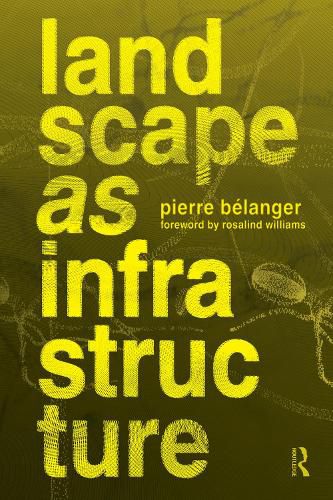Readings Newsletter
Become a Readings Member to make your shopping experience even easier.
Sign in or sign up for free!
You’re not far away from qualifying for FREE standard shipping within Australia
You’ve qualified for FREE standard shipping within Australia
The cart is loading…






As ecology becomes the new engineering, the projection of landscape as infrastructure-the contemporary alignment of the disciplines of landscape architecture, civil engineering, and urban planning- has become pressing. Predominant challenges facing urban regions and territories today-including shifting climates, material flows, and population mobilities, are addressed and strategized here. Responding to the under-performance of master planning and over-exertion of technological systems at the end of twentieth century, this book argues for the strategic design of infrastructural ecologies, describing a synthetic landscape of living, biophysical systems that operate as urban infrastructures to shape and direct the future of urban economies and cultures into the 21st century.
Pierre Belanger is Associate Professor of Landscape Architecture and Co-Director of the Master in Design Studies Program at Harvard University’s Graduate School of Design. As part of the Department of Landscape Architecture and the Advansed Studies Program, Belanger teaches and coordinates graduate courses on the convergence of ecology, infrastructure and urbanism in the interrelated fields of design, planning and engineering. Dr. Belanger is author of the 35th edition of the Pamphlet Architecture Series from Princeton Architectural Press, GOING LIVE: from States to Systems (pa35.net), co-editor with Jennifer Sigler of the 39th issue of Harvard Design Magazine, Wet Matter, and co-author of the forthcoming volume ECOLOGIES OF POWER: Mapping Military Geographies & Logistical Landscapes of the U.S. Department of Defense. As a landscape architect and urbanist, he is the recipient of the 2008 Canada Prix de Rome in Architecture and the Curator for the Canada Pavilion ad Canadian Exhibition, EXTRACTION, at the 2016 Venice Architecture Biennale (extraction.ca).
$9.00 standard shipping within Australia
FREE standard shipping within Australia for orders over $100.00
Express & International shipping calculated at checkout
As ecology becomes the new engineering, the projection of landscape as infrastructure-the contemporary alignment of the disciplines of landscape architecture, civil engineering, and urban planning- has become pressing. Predominant challenges facing urban regions and territories today-including shifting climates, material flows, and population mobilities, are addressed and strategized here. Responding to the under-performance of master planning and over-exertion of technological systems at the end of twentieth century, this book argues for the strategic design of infrastructural ecologies, describing a synthetic landscape of living, biophysical systems that operate as urban infrastructures to shape and direct the future of urban economies and cultures into the 21st century.
Pierre Belanger is Associate Professor of Landscape Architecture and Co-Director of the Master in Design Studies Program at Harvard University’s Graduate School of Design. As part of the Department of Landscape Architecture and the Advansed Studies Program, Belanger teaches and coordinates graduate courses on the convergence of ecology, infrastructure and urbanism in the interrelated fields of design, planning and engineering. Dr. Belanger is author of the 35th edition of the Pamphlet Architecture Series from Princeton Architectural Press, GOING LIVE: from States to Systems (pa35.net), co-editor with Jennifer Sigler of the 39th issue of Harvard Design Magazine, Wet Matter, and co-author of the forthcoming volume ECOLOGIES OF POWER: Mapping Military Geographies & Logistical Landscapes of the U.S. Department of Defense. As a landscape architect and urbanist, he is the recipient of the 2008 Canada Prix de Rome in Architecture and the Curator for the Canada Pavilion ad Canadian Exhibition, EXTRACTION, at the 2016 Venice Architecture Biennale (extraction.ca).